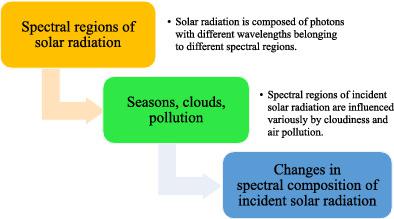当前位置:
X-MOL 学术
›
Q. J. R. Meteorol. Soc.
›
论文详情
Our official English website, www.x-mol.net, welcomes your
feedback! (Note: you will need to create a separate account there.)
Impact of season, cloud cover, and air pollution on different spectral regions of ultraviolet and visible incident solar radiation at the surface
Quarterly Journal of the Royal Meteorological Society ( IF 3.0 ) Pub Date : 2021-05-17 , DOI: 10.1002/qj.4102 Marie Musiolková 1 , Peter Huszár 2 , Martin Navrátil 3 , Vladimír Špunda 3
Quarterly Journal of the Royal Meteorological Society ( IF 3.0 ) Pub Date : 2021-05-17 , DOI: 10.1002/qj.4102 Marie Musiolková 1 , Peter Huszár 2 , Martin Navrátil 3 , Vladimír Špunda 3
Affiliation

|
This study deals with the impact of season, cloud cover, and air pollution on spectral regions of incident solar radiation (UVB, UVA, photosynthetically active radiation (PAR) = Blue + Green + Red, 660, 730 nm) and their ratios (Blue/Red, Blue/PAR, Green/PAR, Red/PAR, 660/730 nm, UVB/UVA, UVB/PAR, and UVA/PAR) measured at three measuring stations at two locations in the City of Ostrava, Czech Republic. The mentioned spectral regions are crucial for plants because they influence photosynthesis and photomorphogenesis. However, there is still a lack of published information about the radiation regime in the plants' environment. The measured data underwent a quality check and were divided into 40 groups corresponding to different combinations of season, cloud cover, and air pollution level. Standard statistical characteristics of spectral regions and their ratios were calculated for each combination. Generalized linear models were used to evaluate the effect of air pollutants on spectral regions of incident solar radiation. Average irradiance values in the spectral regions generally decreased with increasing air pollution on both cloudy and sunny days. A mostly decreasing trend of average values of ratios with increasing air pollution is found mainly on sunny days and, for some cases, even on cloudy days. Each ratio shows a specific patterns depending on the season and cloud cover. The generalized linear models confirm previously published results and underline that air pollution affects various spectral regions of incident solar radiation differently.
中文翻译:

季节、云量和空气污染对地表紫外线和可见光入射太阳辐射不同光谱区的影响
本研究涉及季节、云量和空气污染对入射太阳辐射光谱区域(UVB、UVA、光合有效辐射 (PAR) = 蓝色 + 绿色 + 红色、660、730 nm)及其比率(蓝色/Red、Blue/PAR、Green/PAR、Red/PAR、660/730 nm、UVB/UVA、UVB/PAR 和 UVA/PAR)在捷克共和国俄斯特拉发市两个地点的三个测量站测量。上述光谱区域对植物至关重要,因为它们影响光合作用和光形态发生。然而,仍然缺乏关于植物环境中辐射状况的公开信息。测量数据经过质量检查,并根据季节、云量和空气污染程度的不同组合分为 40 组。计算每个组合的光谱区域的标准统计特征及其比率。广义线性模型用于评估空气污染物对入射太阳辐射光谱区域的影响。在阴天和晴天,光谱区域的平均辐照度值通常随着空气污染的增加而降低。随着空气污染的增加,比率平均值的下降趋势主要出现在晴天,在某些情况下,甚至在阴天。每个比率根据季节和云量显示特定模式。广义线性模型证实了先前公布的结果,并强调空气污染对入射太阳辐射的各个光谱区域的影响不同。广义线性模型用于评估空气污染物对入射太阳辐射光谱区域的影响。在阴天和晴天,光谱区域的平均辐照度值通常随着空气污染的增加而降低。随着空气污染的增加,比率平均值的下降趋势主要出现在晴天,在某些情况下,甚至在阴天。每个比率根据季节和云量显示特定模式。广义线性模型证实了先前公布的结果,并强调空气污染对入射太阳辐射的各个光谱区域的影响不同。广义线性模型用于评估空气污染物对入射太阳辐射光谱区域的影响。在阴天和晴天,光谱区域的平均辐照度值通常随着空气污染的增加而降低。随着空气污染的增加,比率平均值的下降趋势主要出现在晴天,在某些情况下,甚至在阴天。每个比率根据季节和云量显示特定模式。广义线性模型证实了先前公布的结果,并强调空气污染对入射太阳辐射的各个光谱区域的影响不同。在阴天和晴天,光谱区域的平均辐照度值通常随着空气污染的增加而降低。随着空气污染的增加,比率平均值的下降趋势主要出现在晴天,在某些情况下,甚至在阴天。每个比率根据季节和云量显示特定模式。广义线性模型证实了先前公布的结果,并强调空气污染对入射太阳辐射的各个光谱区域的影响不同。在阴天和晴天,光谱区域的平均辐照度值通常随着空气污染的增加而降低。随着空气污染的增加,比率平均值的下降趋势主要出现在晴天,在某些情况下,甚至在阴天。每个比率根据季节和云量显示特定模式。广义线性模型证实了先前公布的结果,并强调空气污染对入射太阳辐射的各个光谱区域的影响不同。
更新日期:2021-05-17
中文翻译:

季节、云量和空气污染对地表紫外线和可见光入射太阳辐射不同光谱区的影响
本研究涉及季节、云量和空气污染对入射太阳辐射光谱区域(UVB、UVA、光合有效辐射 (PAR) = 蓝色 + 绿色 + 红色、660、730 nm)及其比率(蓝色/Red、Blue/PAR、Green/PAR、Red/PAR、660/730 nm、UVB/UVA、UVB/PAR 和 UVA/PAR)在捷克共和国俄斯特拉发市两个地点的三个测量站测量。上述光谱区域对植物至关重要,因为它们影响光合作用和光形态发生。然而,仍然缺乏关于植物环境中辐射状况的公开信息。测量数据经过质量检查,并根据季节、云量和空气污染程度的不同组合分为 40 组。计算每个组合的光谱区域的标准统计特征及其比率。广义线性模型用于评估空气污染物对入射太阳辐射光谱区域的影响。在阴天和晴天,光谱区域的平均辐照度值通常随着空气污染的增加而降低。随着空气污染的增加,比率平均值的下降趋势主要出现在晴天,在某些情况下,甚至在阴天。每个比率根据季节和云量显示特定模式。广义线性模型证实了先前公布的结果,并强调空气污染对入射太阳辐射的各个光谱区域的影响不同。广义线性模型用于评估空气污染物对入射太阳辐射光谱区域的影响。在阴天和晴天,光谱区域的平均辐照度值通常随着空气污染的增加而降低。随着空气污染的增加,比率平均值的下降趋势主要出现在晴天,在某些情况下,甚至在阴天。每个比率根据季节和云量显示特定模式。广义线性模型证实了先前公布的结果,并强调空气污染对入射太阳辐射的各个光谱区域的影响不同。广义线性模型用于评估空气污染物对入射太阳辐射光谱区域的影响。在阴天和晴天,光谱区域的平均辐照度值通常随着空气污染的增加而降低。随着空气污染的增加,比率平均值的下降趋势主要出现在晴天,在某些情况下,甚至在阴天。每个比率根据季节和云量显示特定模式。广义线性模型证实了先前公布的结果,并强调空气污染对入射太阳辐射的各个光谱区域的影响不同。在阴天和晴天,光谱区域的平均辐照度值通常随着空气污染的增加而降低。随着空气污染的增加,比率平均值的下降趋势主要出现在晴天,在某些情况下,甚至在阴天。每个比率根据季节和云量显示特定模式。广义线性模型证实了先前公布的结果,并强调空气污染对入射太阳辐射的各个光谱区域的影响不同。在阴天和晴天,光谱区域的平均辐照度值通常随着空气污染的增加而降低。随着空气污染的增加,比率平均值的下降趋势主要出现在晴天,在某些情况下,甚至在阴天。每个比率根据季节和云量显示特定模式。广义线性模型证实了先前公布的结果,并强调空气污染对入射太阳辐射的各个光谱区域的影响不同。











































 京公网安备 11010802027423号
京公网安备 11010802027423号